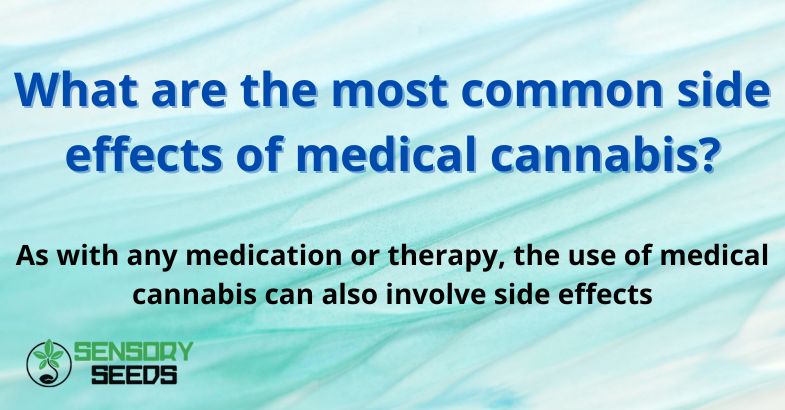Published on: 14/02/2025
As with any medication or therapy, the use of medical cannabis can also involve side effects
It is important to understand that side effects are not the same for everyone but may vary depending on several factors, including dosage, method of administration, individual sensitivity, and the patient’s underlying health conditions.
In this article, we will analyze in detail the most common side effects associated with medical cannabis, delving into their causes, management, and how to minimize potential discomfort for patients.
The Context of Medical Cannabis Use
Before examining the side effects, it is crucial to understand why cannabis is used in the medical field and what its primary active ingredients are. Medical cannabis contains two key chemical components: tetrahydrocannabinol (THC) and cannabidiol (CBD). THC is known for its psychoactive and analgesic effects, while CBD is non-psychoactive but possesses anti-inflammatory, anticonvulsant, and anxiolytic properties.
These active ingredients interact with the human endocannabinoid system, a complex network of receptors present in the brain and other parts of the body, which contributes to regulating essential functions such as sleep, mood, appetite, and pain response. While medical cannabis can provide significant relief for many conditions, such as chronic pain, multiple sclerosis, epilepsy, and anxiety, its side effects should not be underestimated.
Side Effects on the Central Nervous System
One of the areas most frequently affected by the side effects of medical cannabis is the central nervous system. THC, in particular, acts on the brain, influencing cognitive, emotional, and motor processes. The most common effects include:
-
Drowsiness and Fatigue
Many patients report feeling drowsy after using medical cannabis. This effect is more pronounced when the medication contains high levels of THC or is taken in large doses. While this can be beneficial for those suffering from insomnia, it may pose a challenge for individuals who need to stay alert during the day.
-
Dizziness and Confusion
Dizziness is another common side effect, especially among patients who are new to cannabis use. This can occur due to a rapid drop in blood pressure caused by THC, leading to a sensation of lightheadedness or instability.
-
Memory and Concentration Impairments
THC can interfere with short-term memory and reduce the ability to concentrate. For some patients, this may be an obstacle in daily life, particularly if they engage in activities requiring constant mental focus.
Read also : The use of cannabis for the treatment of sleep disorders


Gastrointestinal Side Effects
Medical cannabis can also affect the digestive system, causing side effects ranging from mild to moderate.
-
Nausea and Vomiting
Although cannabis is often used to treat nausea, in some cases, it can cause it, especially when taken in very high doses. This phenomenon, known as cannabinoid hyperemesis syndrome, is rare but can be debilitating.
-
Dry Mouth
One of the most common side effects of cannabis is dry mouth, caused by reduced saliva production. While not serious, it can cause discomfort and increase the risk of cavities if not managed properly.
-
Appetite Changes
Cannabis is well-known for stimulating appetite, but not everyone considers this a positive effect. For some patients, an uncontrollable increase in hunger can lead to weight issues or difficulties in maintaining a balanced diet.
Effects on the Cardiovascular System
Cardiovascular side effects of medical cannabis are less common but still deserve attention, especially in patients with preexisting conditions.
-
Tachycardia
An increased heart rate is one of the most recognized effects of THC. While this phenomenon is usually temporary, it may pose a risk for patients with heart problems.
-
Lower Blood Pressure
As mentioned earlier, cannabis can cause a decrease in blood pressure, leading to dizziness or fainting, particularly if the patient stands up quickly from a sitting or lying position.
Psychological and Behavioral Effects
One of the most debated aspects of medical cannabis involves its psychological effects. While THC can reduce anxiety in some individuals, in others, it can have the opposite effect.
Read also : L’utilisation du cannabis pour le traitement des troubles du sommeil


-
Anxiety and Paranoia
At high doses, THC can trigger anxiety, paranoia, or panic attacks. This is more common in patients with a history of anxiety disorders or those who use cannabis without proper supervision.
-
Mood Changes
Some patients may experience mood swings, ranging from temporary euphoria to irritability. These effects often depend on the product’s composition and the individual’s sensitivity.
-
Psychological Dependence
While medical cannabis carries a lower risk of physical dependence compared to other substances, prolonged or unregulated use can lead to psychological dependence in some individuals.
How to Minimize Side Effects
Managing the side effects of medical cannabis requires a personalized approach and close collaboration with a healthcare professional. Here are some useful strategies:
- Controlled Dosage: Starting with low doses and gradually increasing them can help minimize unwanted side effects.
- Choosing the Right THC-to-CBD Ratio: CBD can mitigate some of THC’s side effects, such as anxiety or cognitive impairment.
- Method of Administration: Vaporization or oral consumption can reduce the risk of side effects compared to smoking.
- Medical Monitoring: Keeping a symptom diary and regularly communicating with your doctor allows the therapy to be adjusted to individual needs.
Conclusions
Medical cannabis offers numerous health benefits, but it is essential to be aware of the potential side effects it may cause. A thorough understanding of possible adverse reactions, combined with responsible and supervised use, ensures that this therapy is utilized effectively, improving patients’ quality of life without compromising their safety.
Remember that everyone reacts differently to medical cannabis: what works for one patient may not be suitable for another. Relying on an experienced professional is the first step toward safe and effective treatment.









